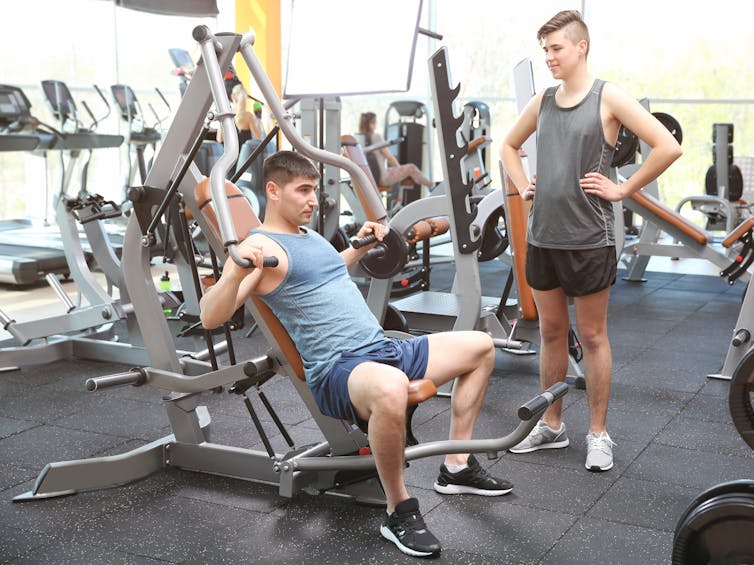Getting in the habit of exercising isn’t easy. Not only is finding the time to exercise a major deterrent for people, the fear of aches, pain and injuries is also a reason that people put off starting a new exercise regime.
But exercise doesn’t necessarily have to lead to pain or injuries. Here are some simple things you can do to avoid these when starting out.
1. Warm up
It’s important to warm up before your exercise. Warming up raises the temperature of the working muscles and the whole body. It also prepares your body for the increased stress of exercise. Muscles that have been warmed up are able to exercise for longer, and suffer less soreness and reduced injury risk.
Exactly what constitutes an effective warm-up varies from workout to workout. But in general, you should dedicate at least five to ten minutes of your workout to warming up. Start with large, whole-body movements such as body-weight squats and lunges before progressing to more task-specific actions – such as a walk or jog before running, or lifting light weights before weight training. Your warm-up shouldn’t be too strenuous. Aim to use only about 40-60% of your maximum effort.
Your warm-up might also include a dose of dynamic stretching (moving a limb through its entire range of movement instead of holding the stretch), but stretching alone is not an effective strategy. You may consider using self-massage tools such as foam rollers instead, as they can help optimise your warm-up. As little as two minutes of foam rolling has been shown to reduce muscle soreness in the days following exercise.
2. Don’t overestimate what you can do
A common mistake when starting a new exercise regime is to do too much. This can lead to pain after workouts, and may also increase your likelihood of injury.
When you first begin a new workout plan, it’s important to start gradually and at your own pace. Since everyone is different, avoid following an exercise programme that uses absolute distances or repetitions. Instead, focus on how you feel during a workout and listen to what your body is telling you.
It can take weeks or even months to notice the benefits of exercise, so don’t expect to see your health and fitness improve overnight. It’s also worth noting that progress isn’t always linear – some days you may find it’s difficult to exercise as long or as hard as you did the previous session. Listen to your body and stop when you feel tired, to avoid injury.
3. Take time to recover
Taking a day or two off to rest each week is vital for recovery. But you don’t just have to sit and do nothing for your recovery days to be effective. Active recovery is equally effective in helping your muscles recover and helping you avoid pain and injury. Active recovery might include lower-effort exercises such as walking or yoga.
While you should take at least one day off between strength training workouts, another strategy to boost recovery is to work different muscle groups on different days. This will stop your muscles from using the same movements over and over, which can lead to overuse injuries.

While aerobic exercise (such as running or cycling) doesn’t usually require as long a recovery period as strength training, mixing up your exercises is still beneficial for avoiding injury. It will provide a more balanced workout and avoid poor movement technique, or form. Rotating between running, swimming, cycling or whatever takes your fancy will allow your body to recover and will help you achieve your fitness goals.
4. Learn proper form
Developing correct form early on is important when starting a new exercise regime to avoid developing bad habits. In the beginning, go slow, try a range of different exercises and don’t add too much weight before you’ve nailed technique. Executing the movements properly will help you avoid injury.
If you choose to exercise at a gym or fitness centre, ask a trainer for pointers if you’re unsure about your form. If you prefer to work out alone, there are lots of resources available online to guide your training. You might also consider filming yourself so you can see how your form looks.
5. Invest in the right shoes
The right pair of shoes can make all the difference to your workouts. It’s particularly important for running, as comfort and support will help reduce soreness and make your runs more enjoyable. You don’t need an expensive shoe either – just one that provides appropriate support for your unique gait, which will help protect vulnerable areas of your feet from overuse injuries.
If you’re looking to start weightlifting, look for flat, hard shoes to provide a bit more stability while you lift. Specialised weight training shoes are also an option, as their raised heel will allow you to achieve the proper ankle, knee and hip angles required for effective lifting. This will let you maintain correct form and reduce risk of injury.
Don’t let the fear of pain or injury put you off from starting a new exercise regime. The benefits of exercise far outweigh the temporary feeling of muscle soreness that can accompany a new exercise regime. Not to mention that as you make exercise a regular habit, you’re less likely to feel sore after each workout.
Lewis Macgregor, Lecturer in Sport, Health & exercise Science, University of Stirling
This article is republished from The Conversation under a Creative Commons license. Read the original article.

